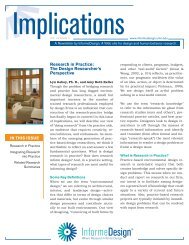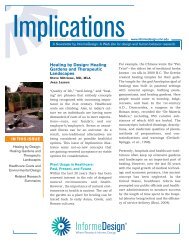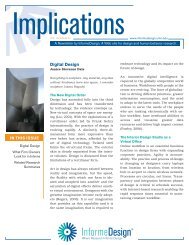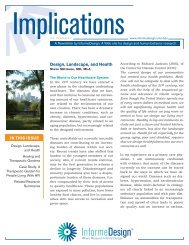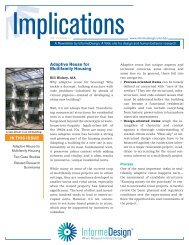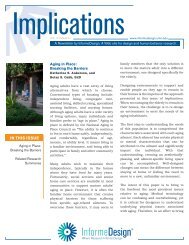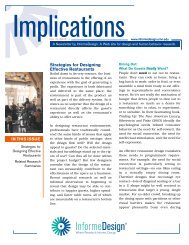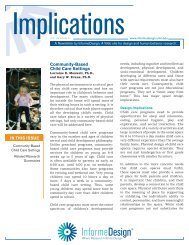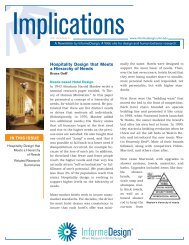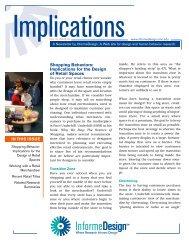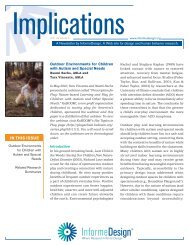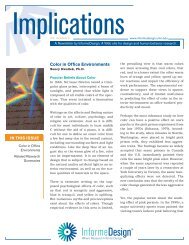Innovative Interior Textiles: Vol. 6, Issue 10 - InformeDesign
Innovative Interior Textiles: Vol. 6, Issue 10 - InformeDesign
Innovative Interior Textiles: Vol. 6, Issue 10 - InformeDesign
You also want an ePaper? Increase the reach of your titles
YUMPU automatically turns print PDFs into web optimized ePapers that Google loves.
Implications<br />
www.informedesign.umn.edu<br />
2<br />
Other new innovations involve nanotechnologies (i.e.,<br />
manipulating material properties at the molecular<br />
level to produce enhanced performance qualities)<br />
that have created new products such as textiles<br />
that detect chemicals and gases, generate mobile<br />
power, and incorporate flexible sensing systems.<br />
Moreover, research is ongoing to develop fabrics<br />
that can reliably carry data and power, which could<br />
open a whole new area of product applications in the<br />
building and interiors markets. The global market for<br />
nanomaterials is expected to reach $4.2 billion by<br />
2011.<br />
Fig. 2: National Aquatic Center, Australia, clad in a bubble wrap made<br />
of ethylene tetra flouro ethylene (ETFE) foil pillows.<br />
Unique <strong>Interior</strong>s Applications<br />
There are five areas where specialty fabrics contribute<br />
to innovations in interiors. New ideas and innovations<br />
are now seen in textile walls, fabric ceilings with<br />
unique properties, integrated fabric lighting, and<br />
unique furniture designs. Equally important, is the<br />
trend of applying outdoor fabrics, such as awning<br />
fabrics or marine cover and seating fabrics indoors.<br />
These high durability fabrics (also called performance<br />
fabrics) are woven like indoor fabrics, with finishing<br />
techniques that create softness for easy draping,<br />
in contrast to the stiff, canvas-like qualities of<br />
traditional outdoor fabrics. Performance fabrics are<br />
selected when requirements call for fade, moisture,<br />
and stain resistance, as well as ease of cleaning.<br />
High-end furniture makers and upholsterers are<br />
requesting performance fabrics more often.<br />
Driving the demand for performance fabrics is the<br />
residential design trend focusing on outdoor living<br />
spaces. Furniture is frequently moved in and out,<br />
and the distinction between spaces is blurred. Fade<br />
resistance is a major selling point of performance<br />
fabrics in states like California and Florida. Ultraviolet<br />
(UV) rays pass through transparent walls (i.e., glass<br />
windows) and open floor plans bring in large amounts<br />
of daylight. Concurrent with the push to outdoor<br />
living is the demand for more textured fabrics for<br />
use on exterior-bound furniture, such as jacquards,<br />
medallion weaves, and dobby textures. Fabrics of<br />
these types cost between $<strong>10</strong>0 to $200 a yard, and<br />
are very durable. “Texture is very big right now,<br />
whether created by weaving techniques or through<br />
use of novelty yarns” (Kleinschmidt, 2008).<br />
Textile Walls<br />
Developments in the application of specialty fabrics<br />
include the application of textiles as interior walls.<br />
Unlike standard wall coverings found in typical office<br />
developments, these textiles have structural qualities.<br />
Tensile fabric structures used for interior walls are<br />
constructed for long-term use. These fabric walls need<br />
to be torqued (like the twist of a propeller blade) to<br />
introduce stiffness to the warp and weft of the fabric<br />
weave. Torqued fabrics minimize flutter and prevent<br />
loose sheets of fabric that could lead to ripped fabric<br />
if left unattended. The construction of these textile<br />
walls is accomplished by the introduction of double<br />
curvature or the “anticlastic” (i.e., surfaces have<br />
double curvature in diametrically opposite directions,<br />
like a saddle.), curving of fabric in two directions at<br />
every point on the surface of the fabric.<br />
Think of a saddle shape: in one direction (x axis)<br />
the form curves upward or outward, in the opposite<br />
Where Research Informs Design®



